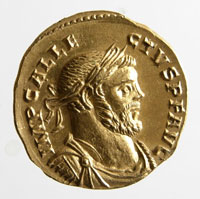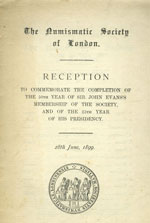Evans the Numismatist
 Gold coin of Allectus (293-296 AD) (Heberden Coin Room) |
While still quite young, Evans developed an interest in coins which led him to start collecting them. Even on the small amount of money paid to him as an allowance by his father and the income he gained from working at the paper mill of his uncle John Dickinson (which was very little), he acquired a significant collection. 'He hunted pawnbroker's shops for coins and bought a new cabinet to house them in' (Time and Chance). In 1848 (aged only 25) he read a paper to an archaeological society at St. Albans on the existence of gold coins in Britain before the Roman invasion. He was described then as no mere amateur collector. His first book, The Coins of the Ancient Britons was published in 1864, for which he was awarded the Prix Allier de Hauteroche of the Académie des Inscriptions et Belles-Lettres in Paris. |
||
Evans was the first person to devise a systematic classification of British Iron Age coinage, based on a descriptive corpus of all types then known. He organised the material by geographical region rather than tribal attribution. His major works were based largely on his own extensive collections; he took a close personal interest in the accompanying illustrations. His contributions to the study of later British coinage were no less significant. He set out a simplified classification of English Short Cross coinage in 1865, consisting of a sequence of five classes. This important publication was submitted as a paper to the Numismatic Chronicle in 1865.
|
|||
Further References / Links:Joan Evans, Time and Chance: The Story of Arthur Evans and His Forebears (1943) See also the chapters by Philip de Jersey, Cathy King and Lord Stewartby in Sir John Evans 1923-1908, ed. Arthur MacGregor , (2008) Numismatic publications by Evans - see the Bibliography of Work By Sir John Evans |
|||

